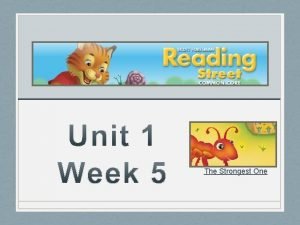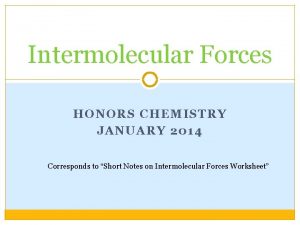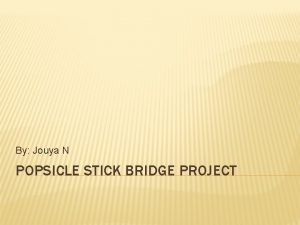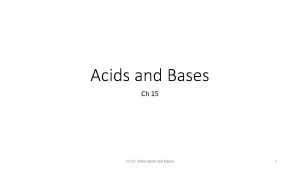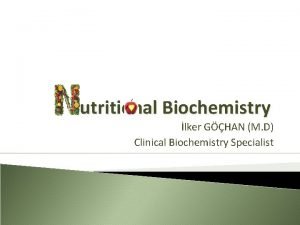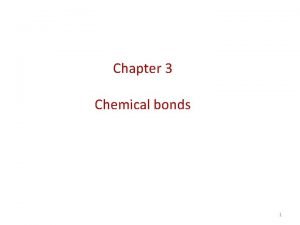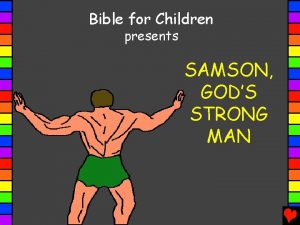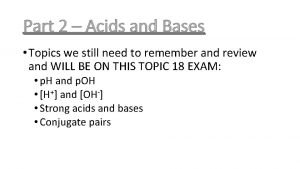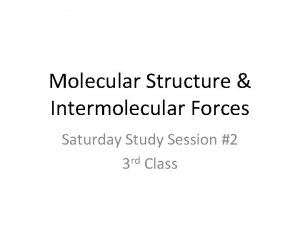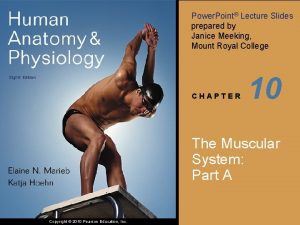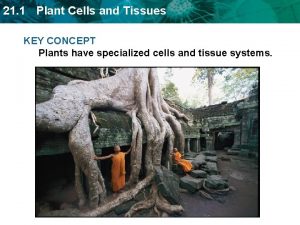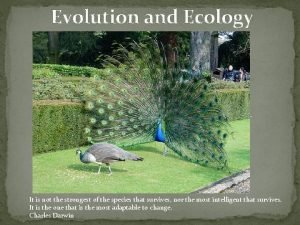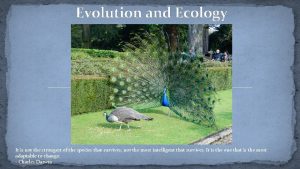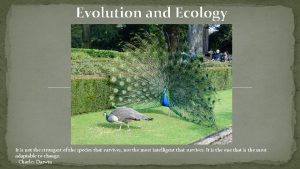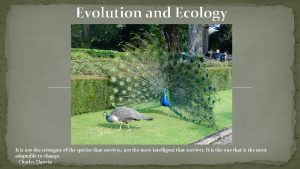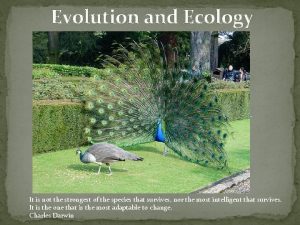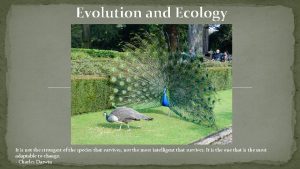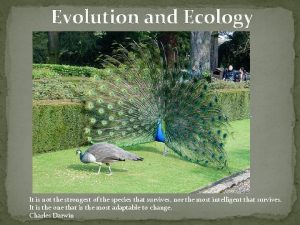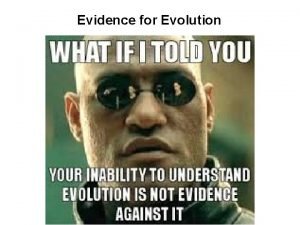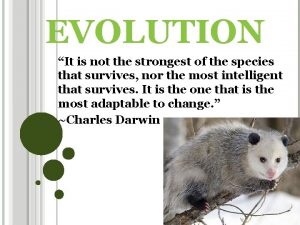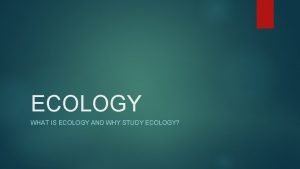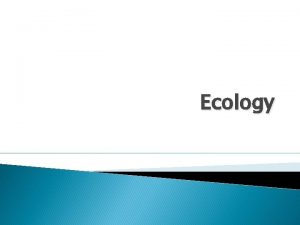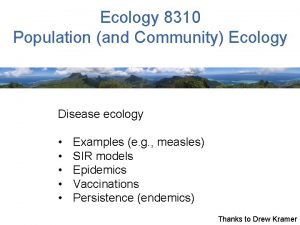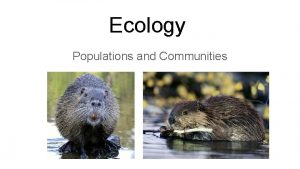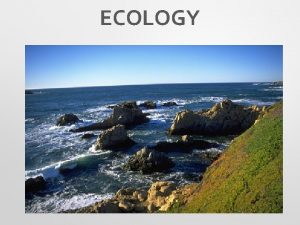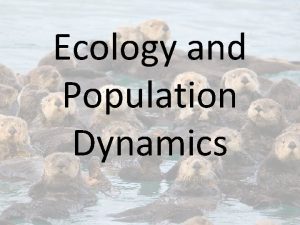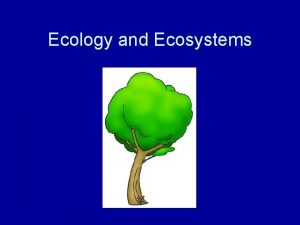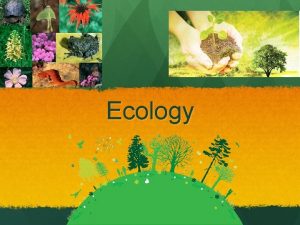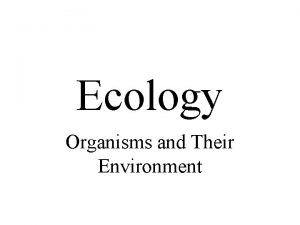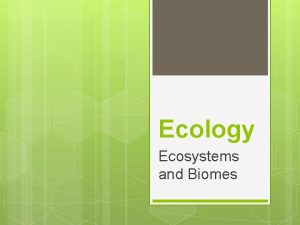Evolution and Ecology It is not the strongest










































- Slides: 42

Evolution and Ecology It is not the strongest of the species that survives, nor the most intelligent that survives. It is the one that is the most adaptable to change. - Charles Darwin

Evolution and Ecology �Evolution is the process by which all of the living organisms on the Earth changed over time from their early ancestor species. �Ecology is the study of the relationships between organisms and the living and nonliving parts of the environment. � Evolution is heavily influenced by these interactions. 2

Levels of Organization �The smallest unit of life that can still respond to its environment, self-replicate, and perform all other biological functions, is the cell. �Groups of cells that have similar shape and function are called tissues. 3

Levels of Organization �Collections of tissues that work together to perform a task in the body are organs. �Organ systems include multiple organs that work together to perform one or more functions. 4

�Ecosystems have similar levels of organization. �An organism is an individual living thing. � A single species of organism is one that is similar enough to breed and produce healthy, fertile offspring. �A population includes all members of a species that live in the same area at the same time. �The biological community is made of all populations living and interacting in one area.

�An ecosystem includes the biological community and its surrounding physical environment. � Nonliving factors like soil, precipitation, etc. �The biosphere is the part of Earth that supports life -- all ecosystems are found here.

Range �Each organism has a particular type of environment where it can survive called its habitat. Habitats are made of two kinds of factors: � Abiotic factors, which include all non- living factors like soil composition, surrounding landforms, climate, etc. � Biotic factors, which include all the living organisms. �These factors establish a geographic range for each organism. 7

�Tolerance ranges are based on the right level of an environmental factor being present. �At the optimal range, population levels will be growing or at their peak. This is the optimal range for that factor. 8

�At the zone of physiologic stress, levels of the factor are too high or too low. The population barely survives. �At the zone of intolerance, the population dies out. 9

�Coniferous trees have a much wider geographic range (zones 3, 5, 6, 7, 8) than broadleaf deciduous trees (zone 8 only). � What biotic and abiotic factors create this range? 10

Adaptations �The geographic and tolerance range of a species is largely defined by the presence of physical, behavioral, or physiologic adaptations. �Physical adaptations are structural differences in coloration, body shape, musculature, etc. The gorilla is adapted for living and feeding on the ground, while chimpanzees gather food from trees. 11

�Behavioral adaptations include migration, or marking a territory. �Physiologic adaptations, such as skin tanning, occur at the cell or tissue level in an organism. 12

Evolution �Within each species is a genetic diversity of small physical, behavioral, and physiologic differences. � The primary source of this variety is random mutations in DNA. �Natural selection describes the process where individuals with certain genes survive and reproduce more successfully than others. � Over time, these genes become more prevalent throughout the population. 13

�Evolutionists will cite three categories of evidence in support of theory. �Physical Similarities � Most animals have similar bones in their limbs (fins, arms, wings). � These similarities can also be found between living species and fossils. �Comparing DNA � Chimpanzees, bonobos, and humans share about 99% of the same DNA. �Vestigial Structures � Still exist in the body but are no longer needed, such as wisdom teeth and the appendix in humans. 14

�An example of natural selection in the human race can be seen in sickle- cell anemia. � Normal red blood cells have a biconcave –disc shape. � Sickle-shaped red blood cells are the result of a single mutated gene. �Sickle cells can get stuck in small blood vessels, causing tissues to become oxygen-deprived. 16

�Individuals with sickle-cell anemia or carriers are also highly resistant to malaria. � The mutation is a disadvantage in climates where malaria is absent due to the long-term health issues. � The mutation is an advantage in climates where malaria is present due to the resistance it provides. Sickle cell gene frequency in Africa. Source: University of Oxford study. Distribution of malaria transmission in Africa. Source: American Journal of Tropic Medicine and Hygeine Study. 17

�Evolution is a very slow process. �Current life on Earth represents billions of years of small mutations and natural selection.

Encouraging Natural Selection �Four ecological factors will “encourage” natural selection to favor certain individuals in a population. �Physiological stress, inappropriate levels of a critical environmental factor. � Moisture, Light, p. H �Predation, when one organism is hunted and killed by another. �Competition, the result of other organisms attempting to use same resources. �Sexual Selection occurs when the female (usually) responds to specific behaviors or physical traits. 19

Speciation �Over a long enough period of time, enough mutations occur that a new species emerges. �When a population splits and become two different species, it is called divergent speciation. 20

�Chimpanzees and bonobos are very closely related primates, with only a few differences between the species. � They likely diverged during a severe drought millions of years ago. 21

�Convergent speciation can occur when natural selection favors unrelated organisms to evolve to look similar. Mantis Fly Praying Mantis 22

Artificial Selection �Artificial selection works on the same principal as natural selection, but with humans driving the selection process. 23

Biodiversity �As a result of evolution, ecosystems have a large biodiversity; the number of different species within an ecosystem or area. �The number of species is unknown. � About 1. 5 million have been identified. � A recent study estimates 8. 7 million exist currently. 24

�The majority of known species are insects, followed by fungi and bacteria. 25

The Taxonomic Naming System �With the tremendous diversity of living organisms, systems have been devised to organize and classify them based on physical traits, DNA, and other characteristics. �The three-domain system classifies organisms based on differences in cellular structure. � Prokaryotes, which have no nucleus or membrane-bound organelles, are classified as archaea and bacteria. � Eukaryotes, which have a nucleus and organelles, have their own domain called Eukarya.

�The five-kingdom classification system starts with these groups: � Monerans, include all prokaryotic organisms. � Protists are a diverse group that includes producers, consumers, single- celled, and multicellular organisms. � Fungi directly absorb nutrients from the external environment. � Plantae includes organisms that are multicellular and can perform photosynthesis. � Animalia are mostly motile, consumers, and eat by ingestion. �Each kingdom has a series of smaller classifications that narrow organisms down into more closely-related groups. � Phylum � Class � Order � Family � Genus � Species 27

�The final two levels of classification, genus and species, are used to devise the scientific name. Taxon Reason Domain Eukarya Cells have nuclei and organelles (eukaryote). Kingdom Animalia Multicellular. Unable to produce own food (heterotrophic). Phylum Chordata Have a nerve cord along the back. Class Mammalia Warm-blooded, gives birth to live young, has hair. Order Primates Forward-facing eyes, enlarged brains, vertical posture. Family Hominidae Capacity for language, culture, empathy. �The final two taxa, genus and species, are used to define the species’ scientific name. �Homo sapiens � Italicized or underlined � Genus capitalized, species lower-case. 28

�The scientific naming system is important, as many species have multiple common names. �The cougar holds the Guinness world record for number of common names, with 40 in English alone! � Cougar, catamount, painter, panther, ghost cat, puma, shadow cat, mountain lion, deer tiger, devil cat, sneak cat, plain lion, fire cat, mountain screamer, Florida panther, silver lion…… Puma concolor 29

�Two animals with many classification levels in common are considered very closely related – they diverged recently. � Wolves and dogs share the same domain, kingdom, phylum, class, order, and family. Canis lupus European Wolf Canis familiaris Domesticated dog 30

Population Growth Patterns �As their ecosystem and community change, populations of organisms undergo different growth patterns. �The most common growth pattern is called logistic growth, which takes the shape of an “S”. 31

�Logistic growth starts off fast, but gradually slows down as the population encounters environmental resistance. �Environmental resistance can come in two forms: � Density-dependent factors, such as disease, which affect dense populations more. � Density-independent factors, such as natural disaster or climate change, which similarly affect all populations. �The carrying capacity is the maximum population that the ecosystem can sustain. 32

�Exponential growth, which takes the shape of a “J”, occurs in the absence of growth-limiting factors. �The population will continue to grow, eventually exceeding the carrying capacity. � This is called an overshoot. �When a population overshoots the carrying capacity, it experiences a dieback, often in the form of massstarvation. �Exponential growth is unusual, and does not typically occur under normal conditions. 33

Community Interactions �How quickly populations grow and the maximum size they attain are often the result of interactions with other populations of organisms. �One of the most basic interactions is predator-prey, where one organism consumes the other. 34

�Competition, where organisms and populations compete for resources, is another common interaction. � Water, food, territory, mates. �When the competition occurs within members of the same species, it is called intraspecific. �When the competition occurs between different species, it is called interspecific. 35

�Some organisms have developed adaptations to avoid directly competing with their own species. � Plants will send their seeds far away to avoid sharing the same soil. � Wolves mark and occupy a territory so they have enough hunting area. � Adult monarch butterflies and their caterpillars each utilize a different part of plants. 36

Symbiosis �The closest relationships of all are symbiosis. These involve a lot of close contact between two species. � When the relationship benefits both organisms, it is called mutualism. � When one organism benefits while the other is unaffected, it is called commensalism. � When one organism benefits at the expense of the other, it is called parasitism. 37

�Barnacles create homes by attaching themselves to whales. The whales are unaffected. 38

�Clownfish have a mucus coating that allows them to live in sea anemones. Their presence attracts other fish for the anemone to eat. 39

�As bison walk through grass, insects are disturbed and fly away. They are eaten by cowbirds. 40

�Ostriches and gazelles feed next to each other. Ostriches have excellent eyesight, while gazelles have stronger senses of hearing and smell. 41

�Mistletoe extracts water and nutrients directly from spruce trees. 42

�The diversity of organisms, genetic traits, relationships, and population growth patterns all combine to create the complex system that is an ecosystem. 43
 Evolution and community ecology guided notes
Evolution and community ecology guided notes Chapter 5 evolution and community ecology
Chapter 5 evolution and community ecology Chapter 5 evolution and community ecology
Chapter 5 evolution and community ecology Sadlier vocabulary workshop level d unit 1
Sadlier vocabulary workshop level d unit 1 Lets try this towers of papers
Lets try this towers of papers Strongest element on earth
Strongest element on earth The strongest one
The strongest one Determine oxidizing agent
Determine oxidizing agent Powerful oxidising agent
Powerful oxidising agent Intramolecular forces vs intermolecular forces
Intramolecular forces vs intermolecular forces Strongest to weakest bonds
Strongest to weakest bonds Strongest to weakest intermolecular forces
Strongest to weakest intermolecular forces Intermolecular forces from strongest to weakest
Intermolecular forces from strongest to weakest Initial depth and outline form
Initial depth and outline form Strongest research design
Strongest research design Besides faithfulness to god what is the strongest value
Besides faithfulness to god what is the strongest value Popsicle sticks bridge project designs
Popsicle sticks bridge project designs What bridge is the strongest
What bridge is the strongest Weak acid concentration
Weak acid concentration Acids and bases
Acids and bases Who is the world's strongest man
Who is the world's strongest man Is a triple bond the strongest
Is a triple bond the strongest The strongest one
The strongest one The polar front jet stream blows ____.
The polar front jet stream blows ____. Unicompositional alloy
Unicompositional alloy Beowulf hero archetype
Beowulf hero archetype Classification of chisel
Classification of chisel The enlightenment
The enlightenment Dagon god
Dagon god Types of fibres
Types of fibres Is triangle the strongest shape
Is triangle the strongest shape Hcn bonding pairs
Hcn bonding pairs Bronsted lowry base examples list
Bronsted lowry base examples list Paper towel projects absorption
Paper towel projects absorption Intra vs intermolecular
Intra vs intermolecular Hydrogen intermolecular forces
Hydrogen intermolecular forces Flexor carpi ulnaris
Flexor carpi ulnaris The strongest plant cells are
The strongest plant cells are Which covalent molecule has the strongest bond o-f n=n o=o
Which covalent molecule has the strongest bond o-f n=n o=o Hình ảnh bộ gõ cơ thể búng tay
Hình ảnh bộ gõ cơ thể búng tay Lp html
Lp html Bổ thể
Bổ thể Tỉ lệ cơ thể trẻ em
Tỉ lệ cơ thể trẻ em






